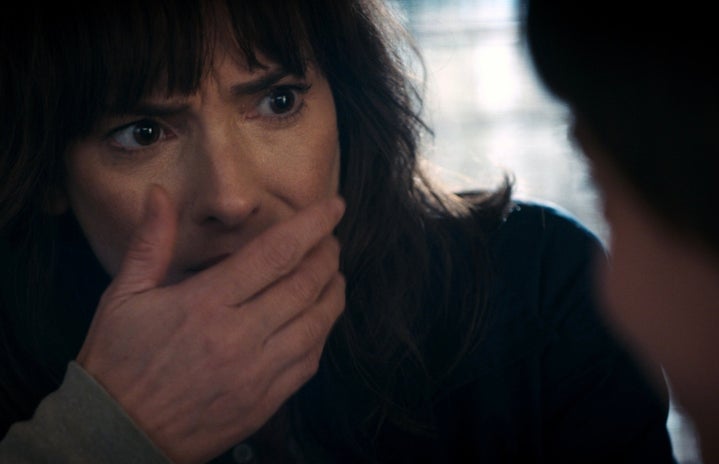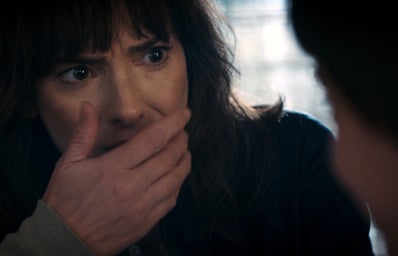A mother dimension
This past summer, the Netflix hit “Stranger Things” premiered its highly anticipated fourth volume. It returned to raucous support, with interest spontaneously rekindled upon the announcement in February 2022 and in the weeks before its release after 3 long years of waiting.
The show’s popularity is attributed to a myriad of elements: the star-studded cast, impeccable timing with the revival of 80s aesthetics, and the unique setup of a show made for adults with child actors at the helm.
By no means were adults completely cast out of the narrative. The most prominent parental figure from the start of the show was always Joyce Byers, the mother of Jonathan and main character Will.
Initially typecast as hysteric non grata, over the years the audience resonated with her distinct “motherness”. Joyce tirelessly advocates for Will when he goes missing in the first season; she is warmed by her boyfriend Bob’s acceptance of her sons and strange circumstances (impending stepfatherhood never said aloud, but imagined until his very last breath).
In the second season, she gives Jim Hopper, our third season newly minted father, sage advice on parenting a daughter whose boyfriend you do not like.
As for the fourth, Joyce travels halfway across the world for the assumed-dead Hopper with a spectacular fervor, faith, and caution-to-the-wind attitude comparable to (and meant to draw a deliberate parallel to) the first season.
David Harbour as Hoppe and Winona Ryder as Joyce in Stranger Things Season 4, Volume 2. Image from netflix.com.
There is something to be said about Joyce’s endless trials and tribulations which can all be snidely categorized as “significant male character is put in danger,” whether that danger is imminent death or the overwhelming yet ultimate temporary scorn of a psionic daughter.
As a side character, this narrative presents a little issue. The storyline, visual effects, and nostalgia-laden soundtrack move along no matter what troubles this small-town, strong-hearted mother. After all, the audience will either sigh with relief with her or quietly observe her grief as they come and go.
In the most reductive sense, Joyce’s character is meant to endure suffering to evoke empathy from the audience. She braves absent ex-husbands, poverty, emotionally immature sons, single motherhood, dead boyfriends, and icy tundras to come out the other side with a tired smile and mild frustration in the way of all mothers.
Recalling her narrative trajectory evokes the question of “how does this look the other way around?” but Joyce’s counterpart Hopper answers this swiftly: it looks the same. Divorced, with one daughter who has passed and another who spends as much of her screentime with him in conflict with him as she does not.
Yet, even in these depictions, the onus of all our empathy is female suffering or its ghost.
‘A gun for every girl’
There is a line to be drawn between the kind of suffering that female audiences are drawn to and the kind that will be instinctively hand-waved as male indulgence (however benign), masquerading as viable plot points that become pronounced in more graphic or long-winded depictions of female suffering.
We see it in the affections for media with female hurt at its center on screen, like Gone Girl, the all at once startling yet captivating styles of Ottessa Moshfegh or Sylvia Plath novels, and the rallying cry for our fleabag eras on social media platforms all summer.
The line is made the most plain in the electrifying opening to Virginie Despentes’ book, King Kong Theory, which begins the first essay, “A gun for every girl,” like this: “I am writing as an ugly one for the ugly ones: the old hags… the frigid, …, the neurotics, the psychos, for all those girls who don’t get a look in the universal market of the consumable chick.”
Despentes’ work generates fanfare among feminists and critics alike for her blunt words and her transparency around the rape that inspires much of it.
Her films and books have unsettled (in the most non-pejorative way possible) audiences since the 90s for the clarity with which she regards the complex experience of women and measured sympathy for men under our current cultural systems, firing off on all cylinders in the haze of late stage capitalism.
Her characters hurt and hurt others with flagrant marksmanship, coolly inconsiderate but never unfeeling.
The distinction is made with the role of female agency. These pieces of media all depict women in distress, women who undergo hardship and suffering as direct and indirect results of a multi-faceted womanhood, and choose to respond to this with some measure of calculation.
This is not an indictment of showing women suffer. Whether they choose to dive headlong into their most self-destructive habits, frame their husbands for murder, or let it all go, they are choosing.
The more extreme, the better. The more ridiculous, the better, because it is all a power fantasy— every woman, to some degree eternally navigating around, underneath, or above her own womanhood, will wish to move free of it.
For that reason, the writing of Joyce Byers’ character, at worst an empathy mine and at best a mother whose storyline was relegated second chair, fails to grant her the level of agency that desperately needs representing (especially when considering the amount of media depicting mothers, especially middle-aged mothers with just as much gusto as a younger counterpart).
Female characters traverse an impossible topography spanning all genres, matched only by the enormity of the female experience that exists in real life.
So when suffering becomes the only in-point for connection with female characters, it reads as a writer’s shortcoming that they couldn’t imagine more for the women they hoped to depict.
What do you want for female characters in our media? Let us know @HerCampusSJSU


